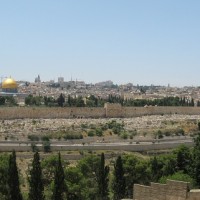Lent 7 (2012)–The Habitation of Peace
A song of ascents. Of David. I rejoiced with those who said to me, “Let us go to the house of the LORD.” Our feet are standing in your gates, O Jerusalem. Jerusalem is built like a city that is closely compacted together. That is where the tribes go up, the tribes of the LORD, to praise the name of the LORD according to the statute given to Israel. There the thrones for judgment stand, the thrones of the house of David. Pray for the peace of Jerusalem: “May those who love you be secure. May there be peace within your walls and security within your citadels.” For the sake of my brothers and friends, I will say, “Peace be within you.” For the sake of the house of the LORD our God, I will seek your prosperity. (Psalm 122:1-9)
Jerusalem—the meaning of this city’s name is remarkable: “habitation of peace.”
Yet in our present day, this “habitation of peace” has shown itself to be a city divided on both religious and political grounds. The Old City has four unequal quarters inhabited by Armenians, Christians, Jews, and Muslims, all claiming Jerusalem by religious authority. This is a city whose internal hostilities mark it as a place of unrest, not peace. It is a city with a biblical history dating back to the record of Abraham and Melchizedek the king of Salem (shalom, peace) in Genesis 14:18-20. Whatever name was given to this City of Peace, sadly it has not lived up to its etymology even to the present day.
Why is that? The Bible records Jesus’ explanation of the unrest which would arise after His final journey to Jerusalem:
As he approached Jerusalem and saw the city, he wept over it and said, ‘If you, even you, had only known on this day what would bring you peace– but now it is hidden from your eyes. The days will come upon you when your enemies will build an embankment against you and encircle you and hem you in on every side. They will dash you to the ground, you and the children within your walls. They will not leave one stone on another, because you did not recognize the time of God’s coming to you’ (Luke 19:41-44).
Jesus and the psalmist agree–the thing that will bring us unifying peace is the presence of God. This is applied to our Lord Jesus Christ in Ephesians 2:13-16:
“But now in Christ Jesus you who once were far away have been brought near through the blood of Christ. For he himself is our peace, who has made the two one and has destroyed the barrier, the dividing wall of hostility, by abolishing in his flesh the law with its commandments and regulations. His purpose was to create in himself one new man out of the two, thus making peace, and in this one body to reconcile both of them to God through the cross, by which he put to death their hostility.”
The writer of our third Song of Ascents joyfully focuses the Jewish pilgrim’s hopes forward to that day by emphasizing:
- The presence of God (as the house of the Lord)
- The unity inspired by worship of Him (as seen in the words us, our, the tribes of the Lord) and
- The peace of Jerusalem.
The psalmist rightly connects all three as inseparable. Only God’s coming to establish Jerusalem as God’s holy city (which is by definition a city completely redeemed from sin) will accomplish this kind of unity and lasting peace. Discipleship Lesson #3 might be called: Seek God’s Presence and Know Peace.
For further meditation:
How does the New Jerusalem of Revelation 21:1-14 look with respect to the presence, worship, and peace of God?



1 Comment
Trackbacks